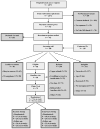Exercise improves body fat, lean mass, and bone mass in breast cancer survivors
- PMID: 19629060
- PMCID: PMC2841468
- DOI: 10.1038/oby.2009.18
Exercise improves body fat, lean mass, and bone mass in breast cancer survivors
Abstract
Given the negative effects of a breast cancer diagnosis and its treatments on body weight and bone mass, we investigated the effects of a 6-month randomized controlled aerobic exercise intervention vs. usual care on body composition in breast cancer survivors. Secondary aims were to examine the effects stratified by important prognostic and physiologic variables. Seventy-five physically inactive postmenopausal breast cancer survivors were recruited through the Yale-New Haven Hospital Tumor Registry and randomly assigned to an exercise (n = 37) or usual care (n = 38) group. The exercise group participated in 150 min/week of supervised gym- and home-based moderate-intensity aerobic exercise. The usual care group was instructed to maintain their current physical activity level. Body composition was assessed at baseline and 6-months through dual-energy X-ray absorptiometry (DXA) by one radiologist blinded to the intervention group of the participants. On an average, exercisers increased moderate-intensity aerobic exercise by 129 min/week over and above baseline levels compared with 45 min/week among usual care participants (P < 0.001). Exercisers experienced decreases in percent body fat (P = 0.0022) and increases in lean mass (P = 0.047) compared with increases in body fat and decreases in lean mass in usual care participants. Bone mineral density (BMD) was also maintained among exercisers compared with a loss among usual care participants (P = 0.043). In summary, moderate-intensity aerobic exercise, such as brisk walking, produces favorable changes in body composition that may improve breast cancer prognosis.
Figures






References
-
- American Cancer Society. Breast Cancer Facts and Figures: 2005–2006. Atlanta: American Cancer Society, Inc; 2006.
-
- Demark-Wahnefried W, Peterson B, Winer E, et al. Changes in weight, body composition, and factors influencing energy balance among premenopausal breast cancer patients receiving adjuvant chemotherapy. J Clin Oncol. 2001;19(9):2381–89. - PubMed
-
- Chlebowski R, Aiello E, McTiernan A. Weight loss in breast cancer patient management. J Clin Oncol. 2002;20(4):1128–43. - PubMed
Publication types
MeSH terms
Grants and funding
LinkOut - more resources
Full Text Sources
Medical

